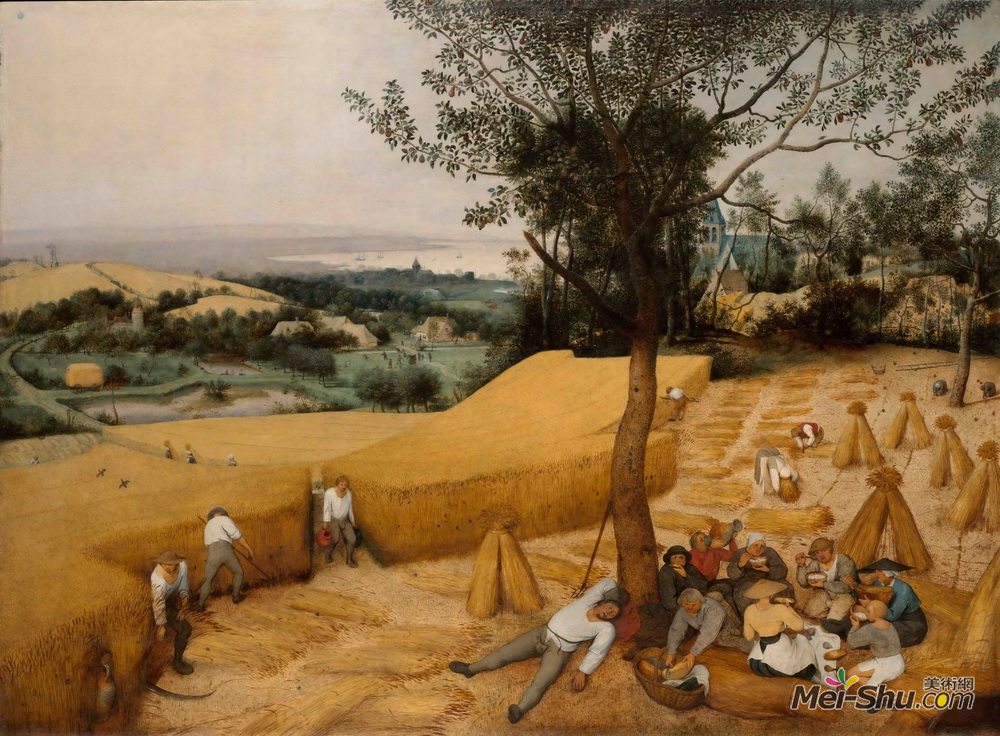
 彼得·勃鲁盖尔(Pieter Bruegel the Elder)高清作品《收割机(七月-8月)》
彼得·勃鲁盖尔(Pieter Bruegel the Elder)高清作品《收割机(七月-8月)》
作品名:收割机(七月-8月)
艺术家:彼得·勃鲁盖尔
年代:1565
风格:北欧文艺复兴
类型:风俗画,景观
介质:油画,面板
标签:休闲与睡眠
尺寸:116.5 x 159.5 cm
收藏:大都会艺术博物馆(MET),纽约市,纽约州,美国
《收割机》是安特卫普富有的商人尼古拉斯·约翰林克委托布鲁格尔创作的一系列六人作品中幸存的五幅画之一,显然是他郊区住宅特贝肯餐厅的一大装饰方案。其他四幅画分别是《阴郁的日子》、《雪中的猎人》、《牛群归来》(全是维也纳的昆士多利亚博物馆)和《干草》(布拉格洛布科维奇收藏)。虽然Jongelinck的1566册中列出了艺术家的“16幅”,但是只有两幅独立的作品和十二月刊(12个月)的名字被提及,这表明该系列最初可能包括十二幅画。然而,到1595年,当这些镶板被安特卫普市购买并作为礼物赠送给安斯特公爵时,它们被描述为代表十二个月的六幅画。尽管最初的版面数量仍然是一个悬而未决的问题,但是大多数学者现在认为只有六个版面,因为传统上在当代历法系列(在照明手稿中很常见的主题)中会在两个月内出现的场景被包括在单个图像中。这个画板通常被认为是代表七月至八月或夏末。布鲁格尔的画作《春天》(维也纳,阿尔伯蒂娜)是由艺术家“De Le.Meert.Meij”题写的,在题材上可能与缺失的画板相似,这些画板大概代表四月至五月或初的月份。普林。
Title:The Harvesters (July–August)
artist:Pieter Bruegel the Elder
Date:1565
Style:Northern Renaissance
Genre:genre painting, landscape
Media:oil,panel
Tag:leisure-and-sleep
Dimensions:116.5 x 159.5 cm
Location:Metropolitan Museum of Art (Met), New York City, NY, US
The Harvesters is one of five surviving paintings from a probable group of six, a series commissioned from Bruegel by the wealthy Antwerp merchant Niclaes Jongelinck, apparently as an extensive decorative scheme for the dining room of his suburban home, Ter Beken. The four other paintings of the group are the Gloomy Day, Hunters in the Snow, and the Return of the Herd (all Kunsthistorisches Museum, Vienna), and Haymaking (Lobkowicz Collections, Prague). Although "16 pieces" by the artist are listed in Jongelinck's 1566 inventory, only two independent works and the Twelff maenden (twelve months) are mentioned by name, suggesting that the series may originally have included twelve paintings. By 1595, however, when the panels were purchased by the city of Antwerp and presented as a gift to Archduke Ernst, they are described as six paintings representing the twelve months. Although the original number of panels remains an open question, most scholars now believe there were only six panels, as scenes that would traditionally have appeared in two separate months in contemporary Calendar series (a theme common in illuminated manuscripts) are included in a single image. This panel is usually identified as representing July–August, or late summer.Bruegel's drawing Spring (Albertina, Vienna) is inscribed by the artist "De Lenten Meert April Meij," and may resemble in subject the missing panel of the months that presumably represented April-May or early spring.
作品名称:《收割机(七月-8月)》彼得·勃鲁盖尔(Pieter Bruegel the Elder)高清作品欣赏
作品链接:https://www.mei-shu.com/famous/27315/artistic-117028.html
作品类别:油画
免责声明:本站部分公开资料来源于互联网,目的是用于学术交流与讨论,并不代表本网赞同其观点和对其真实性负责。如果您认为我们的侵犯了您的权益,请与我们联系(banquan#mei-shu.com #替换为@),我们将在第一时间删除相关内容。